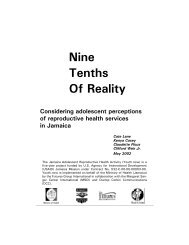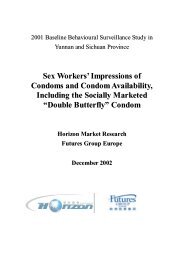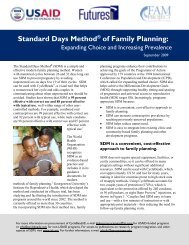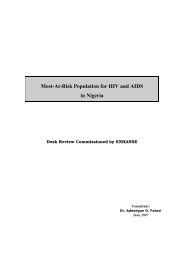Health Policy Issues and Health Programmes in ... - Amazon S3
Health Policy Issues and Health Programmes in ... - Amazon S3
Health Policy Issues and Health Programmes in ... - Amazon S3
- No tags were found...
Create successful ePaper yourself
Turn your PDF publications into a flip-book with our unique Google optimized e-Paper software.
IEC for <strong>Health</strong> <strong>Programmes</strong> <strong>in</strong> Uttaranchalmarried women have an unmet need for spac<strong>in</strong>g <strong>and</strong>, similarly, 11% for limit<strong>in</strong>g. The unmetneed for spac<strong>in</strong>g is 44% among women aged 15–19, which decl<strong>in</strong>es with age. Also, the unmetneed for limit<strong>in</strong>g <strong>in</strong>creases with age <strong>and</strong> is 16% among women aged 30–34. The preference forsons is also an issue among women. For example, for women with two liv<strong>in</strong>g children,contraceptive use is only 22% if both children are daughters, 41% if there is one daughter <strong>and</strong>one son, <strong>and</strong> 58% if both children are sons.While the <strong>in</strong>fant mortality rate <strong>in</strong> Uttaranchal is 38, this <strong>in</strong>dicator is worse for children frompoorer <strong>and</strong> less-educated families. However, the <strong>in</strong>fant mortality rate (IMR) is over 60% greateramong children born to mothers age 20 or less as compared with mothers ages 20–29 (an IMR of69 versus 43). Also, <strong>in</strong>fant mortality is more than four times greater among children born lessthan 24 months after a previous birth (110 compared with 23 for children born after a gap ofmore than 24 months).Use of health services dur<strong>in</strong>g pregnancy, delivery, <strong>and</strong> after childbirth rema<strong>in</strong>s low. Only 21% ofdeliveries are at medical facilities. Antenatal care (ANC) <strong>in</strong>dicators, such as iron <strong>and</strong> folic acid(IFA) consumption <strong>and</strong> tetanus toxoid (TT) immunization, are also low. However, what is mostworrisome is that 41% of currently married women report some type of reproductive healthproblems; but almost 70% of these women have not sought any advice. Only 12% have soughtadvice or treatment at government facilities.NutritionThe prevalence of anaemia is particularly high among children <strong>and</strong> women. More than threequartersof children under three years are anaemic. Children whose mothers are anaemic are <strong>in</strong>turn more likely to suffer from anaemia. Similarly, more than 40% of children under age 3 aremalnourished, while one-third of women have this problem. Malnutrition of children can partlybe attributed to the fact that only 13% of children aged 6–9 months receive the recommendedcomb<strong>in</strong>ation of breast milk <strong>and</strong> solid foods, <strong>in</strong> spite of the fact that breastfeed<strong>in</strong>g is nearlyuniversal <strong>in</strong> Uttaranchal. However, due to ignorance, colostrum is not given by almost threefourthsof the women, <strong>and</strong> the median duration of exclusive breastfeed<strong>in</strong>g is only 2.6 months.Burden of DiseaseAlthough the prevalence of tuberculosis (TB) is low, almost two per cent of the population at anytime is suffer<strong>in</strong>g from asthma, two per cent from malaria, <strong>and</strong> about one per cent from jaundice.At any given time, one-quarter of all children suffer from fever, 17% from acute respiratory<strong>in</strong>fection (ARI), <strong>and</strong> 18% from diarrhoea. The ability of people to underst<strong>and</strong> <strong>and</strong> treat thesesymptoms is poor. For <strong>in</strong>stance, almost 20% of mothers believe that dur<strong>in</strong>g a bout of diarrhoea,the child’s fluid <strong>in</strong>take needs to be reduced.88Empowerment <strong>and</strong> Service DeliveryDomestic violence is widespread. More than 10% of women have experienced beat<strong>in</strong>gs, <strong>and</strong>, ofthose, one-third feel that their husb<strong>and</strong>s are justified <strong>in</strong> wield<strong>in</strong>g the stick. Only four per cent ofwomen receive home visits from health workers, <strong>and</strong> nearly two-thirds of women of Uttaranchalhave not even heard about HIV/AIDS. Among the women who have heard about HIV/AIDS, 37%







